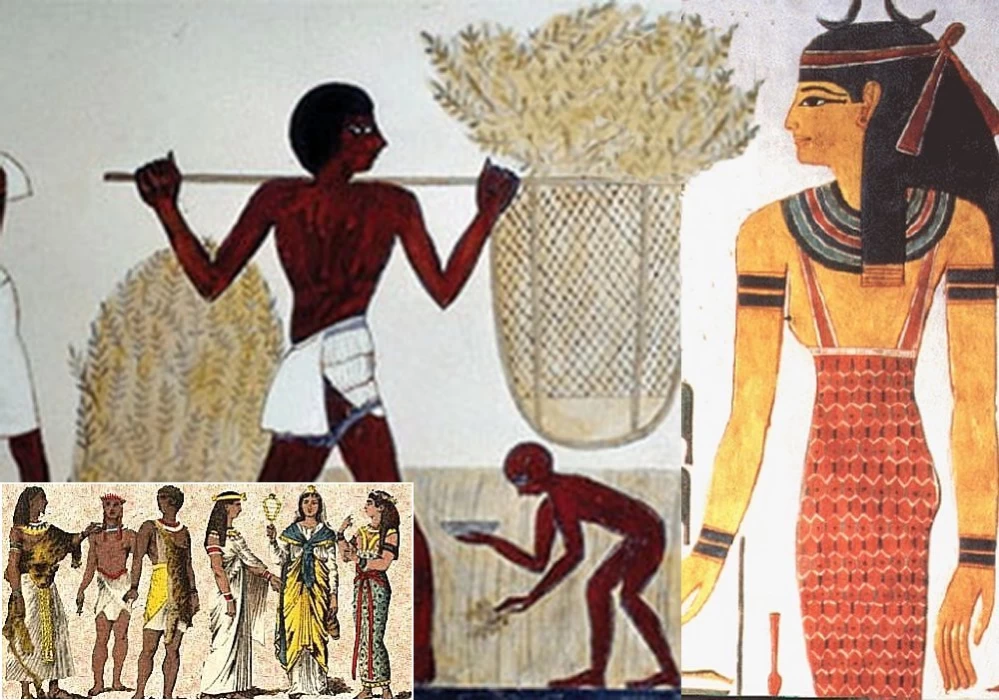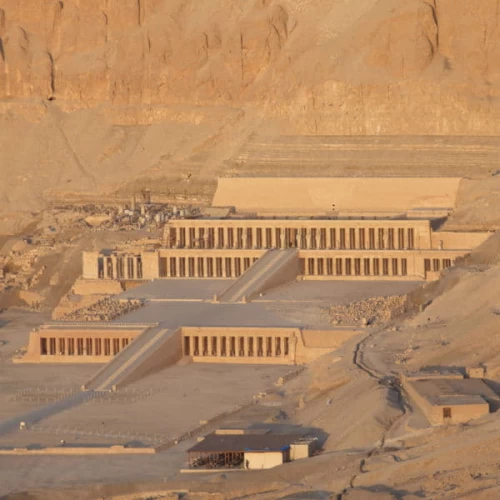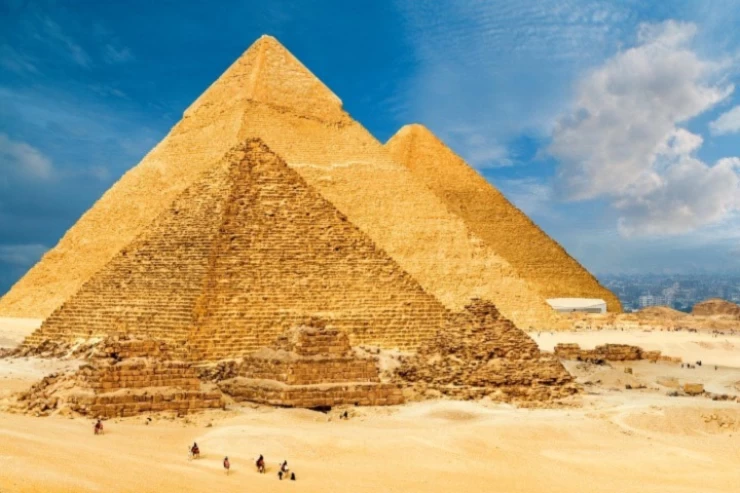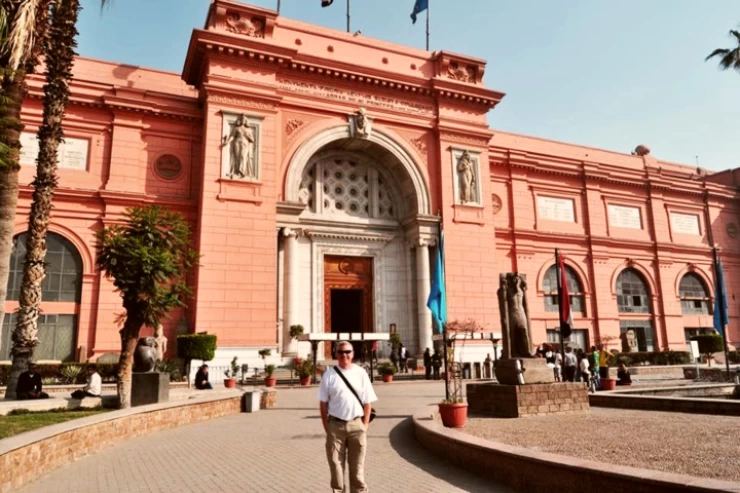
Ropa en el antiguo Egipto
La ropa del antiguo Egipto se refiere a la ropa usada en el antiguo Egipto desde el final del período neolítico (antes del 3100 a. C.) hasta el colapso del reino ptolemaico con la muerte de Cleopatra en el 30 a. C. La ropa egipcia estaba llena de una variedad de colores. Adornadas con gemas y joyas preciosas, las modas de los antiguos egipcios no solo estaban hechas para la belleza sino también para la comodidad. La moda egipcia fue creada para mantenerse fresco en el cálido desierto.
En el antiguo Egipto, el lino era, con mucho, el textil más común. Ayudó a las personas a sentirse cómodas en el calor subtropical. El lino es hecho de la planta de lino al hacer girar las fibras del tallo de la planta. El hilado, el tejido y la costura eran técnicas muy importantes para todas las sociedades egipcias. Los tintes de plantas se pueden aplicar a la ropa, pero la ropa generalmente se deja en su color natural. La lana era conocida pero considerada impura. Solo los ricos llevaban fibras animales que eran objeto de tabúes. En ocasiones se usaban para abrigos, pero estaban prohibidos en templos y santuarios.
Los campesinos, trabajadores y otras personas de condición modesta a menudo no llevaban nada, pero el olor (hecho de lino) era usado por todas las personas. Los esclavos a menudo trabajaban desnudos.
El tocado más común era el khat o nemes, una tela rayada que usaban los hombres.
Desde aproximadamente el año 2130 aC durante el Antiguo Reino, las prendas eran simples. Los hombres llevaban faldas envolventes conocidas como shandy, que tenían cinturones en la cintura, a veces plisados o fruncidos en la parte delantera. Durante este tiempo, las faldas de los hombres eran cortas. Cuando llegó el Reino Medio de Egipto (1600 a. C.), la falda se usó por más tiempo. Luego, alrededor de 1420 a. C., había una túnica o blusa ligera con mangas, así como una enagua plisada.
Durante el Antiguo, Medio y Nuevo Reino, las mujeres egipcias antiguas en su mayoría usaban un vestido sencillo llamado kalasiris. La ropa de las mujeres en el antiguo Egipto era más conservadora que la ropa de hombre. Los vestidos se sostenían con una o dos correas y se usaban hasta el tobillo, mientras que el borde superior se podía usar encima o debajo de los senos. La longitud del vestido denotaba la clase social del usuario. Las cuentas o las plumas también se usaron como adorno en el vestido. Sobre el vestido, las mujeres tenían la opción de usar chales, capas o túnicas. El chal era una pieza de lino fino de alrededor de 4 pies de ancho por 13 o 14 pies de largo. Esto también se usaba principalmente plisado.
Los niños no usaban ropa hasta los 6 años. Una vez que cumplieron seis años, se les permitió usar ropa para protegerlos del calor seco. Un peinado popular entre los niños era el mechón lateral, una longitud de cabello sin afeitar en el lado derecho de la cabeza. Aunque los niños generalmente no usaban ropa, usaban joyas como tobilleras, pulseras, collares y accesorios para el cabello. Cuando crecieron, usaban los mismos estilos que sus padres.
Pelucas
Las pelucas eran usadas por los ricos de ambos sexos. Hechos de cabello humano y a veces complementados con fibra de palma datilera, a menudo se peinaban con rizos apretados y trenzas estrechas. Para ocasiones especiales, tanto hombres como mujeres podrían cubrir sus pelucas con conos de grasa perfumada que se derretirían para liberar su fragancia y acondicionar el cabello.
Joyería
La joyería era muy popular en el antiguo Egipto, sin importar la clase social. Era pesado y bastante voluminoso. La razón principal para usar joyas es por su función estética. Los egipcios vestían sobriamente con telas de lino blanco y las joyas ofrecían una posibilidad de contraste. La preferencia egipcia era hacia el uso de colores brillantes, piedras brillantes y metales preciosos. El oro se ganó en grandes cantidades en el desierto oriental de Egipto, pero también vino de Nubia, que fue una colonia egipcia durante siglos.
Por otro lado, la plata era rara y se importaba de Asia. Por lo tanto, era plata que a menudo se consideraba más preciosa que el oro. El desierto oriental también fue una fuente importante de coloridas piedras semipreciosas como cornalina, amatista y jaspe. En el Sinaí había minas de color turquesa, el lapislázuli azul profundo tenía que provenir del lejano Afganistán. El vidrio y la loza (esmalte sobre un núcleo de piedra o arena) eran los favoritos para reemplazar las rocas porque podían producirse en muchos colores.
Los egipcios se volvieron muy hábiles al hacer joyas de turquesa, metales como oro y plata, y pequeñas cuentas. Tanto los hombres como las mujeres se adornaron con aretes, pulseras, anillos, collares y collares de colores brillantes. Aquellos que no podían pagar las joyas hechas de oro u otras piedras harían sus joyas con cuentas de cerámica de colores.
Productos cosméticos
El embalsamamiento permitió el desarrollo de cosméticos y perfumes. [Se necesita aclaración] Los perfumes de Egipto fueron los más numerosos, pero también los más buscados y los más costosos de la antigüedad, que los utilizó ampliamente. Los egipcios usaban maquillaje sobre todo la gente antigua. Las uñas y las manos estaban pintadas con henna.
El kohl negro, que se usaba para marcar los ojos, se obtuvo de galena. La sombra de ojos estaba hecha de malaquita triturada. El rojo, que se aplicaba a los labios, provenía del ocre. Estos productos se mezclaron con grasa animal para hacerlos compactos y preservarlos. Llevaban galena o malaquita triturada no solo para realzar la belleza, sino porque creían que evitaba que el polvo y la suciedad se les metieran en los ojos. Por esta razón, tanto hombres como mujeres lo usaban.
Calzado (los zapatos)
El calzado era igual para ambos sexos. Consistía en sandalias de cuero, o para la clase sacerdotal, papiro. Como los egipcios solían estar descalzos, las sandalias se usaban en ocasiones especiales o en momentos en que sus pies podían lastimarse.
Tenemos las mejores ofertas para que disfrute de una variedad de viajes y vacaciones clásicas de Egipto personalizados, viajes privados de presupuesto a Egipto y paquetes de viaje a Egipto para satisfacer todos sus sueños sobre el antiguo Egipto, la cuna de las civilizaciones, lo ayudaremos a planificar sus paquetes clásicos a Egipto y cubren la mayor parte de la tierra de los faraones, entonces le dejaremos probar la más alta calidad de servicio de viaje ofrecido por los guías de Cairo Top Tours. Reserve ahora para una gran experiencia de vacaciones en Egipto y paquetes de vacaciones en Egipto para visitar la increíble Giza. pirámides y la esfinge, el Museo Egipcio, el valle de los reyes, el Cairo copto e islámico, así como el templo de Abu Simbel y todas las maravillas del antiguo Egipto .
A Brief Analysis of Policy, Cultural, and Historical MilieusThe costumes of ancient Egypt carry an immense weight in comprehending the social, cultural, and religious relations of one of the most complex civilizations in the world. Clothing played an essential role in the lives of the ancient Egyptians; it was not worn solely to cover the body. Rather, it signified social class, sex, occupation, and religion, all of which were in harmony with the surroundings and the sophisticated civilization that the people of the Nile River developed.
Linen is the Fabric of Choice in the ancient Egyptian clothes.
In ancient Egypt, one of the most popular and numerous textiles was the flax linen, which was predominantly cultivated along the banks of the Nile. The high temperatures in Egypt made it unavoidable to wear light and porous materials; hence, linen became the most appropriate material to use. All the same, the process of making linen from the flax plant was rather labor-intensive because it involved soaking the plant, pounding it down to retrieve fewer strands of it, and finally, yarn coming from those strands.
Zibellina esdromis fine-quality linen was especially popular with the nobles’ elite. The most advanced, termed "palace linen," was quite light but stable, glossy, and a bit transparent, indicating that it was designed for the affluent class. Nobility and priests, including the pharaohs, wore the most delicate and immaculate white linen attires, which were also for royalty due to their unblemished look and spiritual aspect, while the lower class dressed in the most tattered and coarse fabrics.
The clothing worn by the elite reflected their position, riches, and belief in their godliness. As earthly gods, the Queen and Pharaoh donned fashionable elements of clothing infused with various images. One of the most popular items of clothing worn by the pharaoh was the'shendyt’, a tailored pleated skirt that was extended with both gold and gem decorations. It was held in place by a decorative sash and, at times, was worn with a beautifully crafted robe or jacket for events.
Pharaohs also had a piece of headgear that was almost a statue of a king, called the ‘names’, which is a striped fabric wrapped around the head and tied at the back. All three, together with the false beard, the headdress of a king, and crowns with either the white or red crown of Egypt or the double crowns of Egypt—a sign of authority and power, only that it was royal power.
They wore clothes similar to those of the pharaoh but not as ostentatious. Richer men and women wore complex necklaces that included gold and colored stones. Their dresses were elaborately designed to exhibit their social class, with women frequently dressing in body-hugging sheaths made out of quality linen.
As the elites displayed their opulent clothing, the vast majority of the Egyptian population, consisting of farmers, laborers, artisans, and servants, put on simpler clothes. Working-class men were mostly found dressed in a simple loincloth or a knee-length coarser linen kilt. The tunic dresses worn by women were no exception and were specially designed to facilitate a woman's domestic and daily activities.
In spite of having simple clothing, it was clear that they took time and effort in the way they looked. The cleanliness and general appearance of the Egyptians of all social classes were important, and this can be attributed to the fact that they applied perfumes, oils, and cosmetics on a daily basis as part of their dressing code.
Religious and ceremonial costumes
Religious beliefs and practices permeated every aspect of daily life in ancient Egypt; hence, the costumes worn during religious and ceremonious activities depicted the outlook of the society. To express their sanctity and the god’s role they were playing, priests wore linen white robes. Most high priests were draped in leopard-skin cloaks, which were worn around the robe’s bust region during the ceremony to indicate closeness to the gods.
Dresses of deities were often characterized by very elaborate and expensive garments, with some, like goddess Hathor, even dressed in detailed sheath dresses. The meaning behind the use of practical animal skins and feathers, as well as ornamental pieces, was to call for the presence of divine beings and their goodwill.
Moreover, no attire in ancient Egypt would be complete without the inclusion of ornamental pieces. For the ancient Egyptians, jewelry had a purpose beyond mere decoration; it was considered to be a protective talisman worn against dark forces. Everyone, regardless of rank, embellished and decorated themselves with intricate pieces of jewelry, such as neckpieces, ear decorations, wrist and ankle covering ornaments, and even finger bands.
Rings, earrings, necklaces, and other kinds of jewelry were usually very expensive things because they were made from gold and other precious stones for the rich class, whereas the lower class spent less on ornamental copper, bronze, or colored glazed beads.
In the history of mankind, when different civilizations have flourished and left behind valuable artifacts, amulets have also been widely utilized among the ancient Egyptians. They were not merely decorative charms worn on a necklace or a bracelet, which was the fashion of the day; they also represented gods, animals, and other holy things believed to give protection in life and death.


















